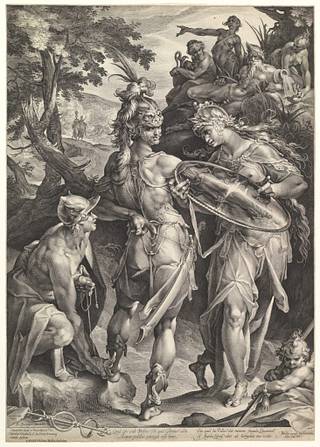
Similar
Jan Muller - Minerva and Mercury Arming Perseus
Summary
Public domain photo of Dutch art print, 17th century, free to use, no copyright restrictions image - Picryl description.
The Dutch Golden Age was a period from 1581 to 1672, when the Netherlands experienced the "Dutch Miracle", transcended to the foremost maritime and economic power. In 1568, the Seven Provinces started a rebellion against Philip II of Spain, leading to the Eighty Years' War with Spain and the Thirty Years' War between other European superpowers. Protestants moved from the southern to the northern Netherlands, many settled in Amsterdam, transforming a port town into one of the most important commercial centers in the world by 1630. In addition to the migration of Protestants, there were also influxes of refugees who had previously fled from religious persecution, particularly Sephardi Jews from Portugal and Spain, and Protestants from France. Catholics moved in the other direction - to the southern provinces, modern Belgium. North quickly gained the highest literacy rates in Europe, an abundance of capital, the largest merchant fleet in Europe. The Dutch dominated trade in the Baltic Sea, between China and Japan, and with the English colonies in North America. The Dutch East India Company (VOC) was the first multinational corporation, financed by shares that established the first modern stock exchange. The Bank of Amsterdam, the first central bank, was established in 1609. The Dutch Golden Age is the art period dominanted by Rembrandt, Vermeer, Jacob van Ruisdael, and Frans Hals. Some notable artistic styles and trends include Haarlem Mannerism, Utrecht Caravaggism, the School of Delft, the Leiden fijnschilders, and Dutch classicism. 1672 is called a disaster year" when the Dutch Republic was attacked by England, France, Münster, and Bavaria. The invading armies quickly defeated most of the Dutch States Army and conquered part of the Republic.
Bartholomeus Spranger was a Flemish painter, draughtsman and etcher who lived and worked in Antwerp, Prague and Vienna. He was born in Antwerp in 1546 and trained with the painter Jan Mandijn. Spranger became master of the Antwerp Guild of St. Luke in 1565. In 1568 Spranger left Antwerp and travelled to Italy, where he studied the works of Michelangelo, Raphael and Titian. He also spent some time in Rome working for Cardinal Alessandro Farnese. In 1575 Spranger moved to Prague, where he worked as a court painter for Emperor Rudolf II. He became known for his highly refined and elegant style, influenced by Mannerism and the Italian Renaissance. Spranger's paintings often depicted mythological and allegorical subjects, and his figures were characterised by elongated proportions and graceful poses. Spranger remained in Prague until 1591, when he moved to Vienna to work for Emperor Rudolf's successor, Emperor Matthias. He died in Vienna in 1611. Spranger's work had a significant influence on the development of Baroque art in Central Europe. His paintings were highly sought after by collectors and patrons, and he was widely regarded as one of the most important artists of his time.
Tags
Date
Source
Copyright info


























